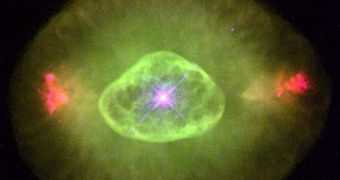Poets are well acquainted with the flickering of stars, which is sung in countless poems and works of art. Astronomers are equally as familiar, and also frustrated, with this flickering, because it means the atmosphere is interfering with their observations of very distant celestial objects. But there is another stage in a star's life, right near its very end, when the object appears to be literally dancing in the evening sky. Astronomers have been very curious to learn what's going on inside the cosmic fireballs when this happens, and now they'll get a chance to study the phenomenon in more depth.
Over the next two weeks or so, the Whole Earth Telescope will be keeping a close eye on three such dying stars, in a bid to discover the physical phenomena underlying the changes they experience. The WET is an international network of cooperating astronomical observatories, which operates under the direction of experts at the University of Delaware, in the United States. Together, these facilities can ensure around-the-clock surveillance of targets of interest, giving astronomers a way of observing variations occurring over very small time frames, ScienceDaily reports.
GD358, a white dwarf star based in the constellation Hercules, is the main target for the new effort. Like most other objects of its class, it's mostly made up of helium, having already exhausted its supply of hydrogen. The body can no longer sustain nuclear fusion, and has a surface temperature of about 19,000 Kelvin. “We recently discovered that this star is pulsating a little strangely, and we are looking for signs that it is spinning like a top,” the Director of the UD Delaware Asteroseismic Research Center, Judi Provencal, explains. She is also an assistant professor of physics and astronomy at the university. “The Sun will one day become a white dwarf star, which is why we're interested in knowing more about them and what happens to any planets the original star might have had,” she adds.
The second target is PG1325+101, a rapidly pulsating star in the constellation Virgo. The reason why this object was designated for investigations is that astronomers believe it holds one or more exoplanets in orbit. The third target is WD1524, located in the constellation Serpens. It was observed before, during the WET 2009 international campaign. “How stars pulsate depends on their structure and composition. Last year, WD1524 completely changed how it was pulsating. Imagine ringing the Liberty Bell and having it sound like a hand bell. That would be hard to do. We don't understand how this happens with our pulsating stars. We now know that this star has changed yet again, so we are trying to understand how that can happen. Our current theoretical models of white dwarfs don't predict this sort of behavior,” Provencal concludes.

 14 DAY TRIAL //
14 DAY TRIAL //